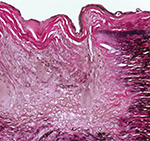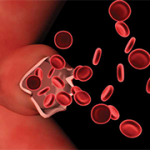
Ditty_about_summer / shutterstock.com
For patients with refractory Takayasu arteritis (TAK), glucocorticoids (GCs) are often provided as the initial therapy for treatment. However, GCs are often associated with adverse effects for long-term use; relapse also occurs frequently during GC tapering.1 TAK involves interleukin (IL) 6. Tocilizumab—a recombinant, humanized, anti-IL-6 receptor (IL-6R) monoclonal antibody—was first reported by Nishimoto et al. for the successful treatment of a patient with TAK.2 Previous research investigating tocilizumab for patients with refractory TAK, in case reports and observational studies, has also demonstrated clinical responses and a steroid-sparing effect.3
Findings from the TAKT study, a randomized, double-blind, placebo-controlled, phase 3 trial in Japan, is the first comparative study of its kind to investigate the efficacy and safety of tocilizumab in patients with TAK. This research provides new data suggesting “tocilizumab may possess consistent clinical benefits or steroid-sparing effects in patients with Takayasu arteritis,” according to Yoshiya Tanaka, MD, one of the TAKT study investigators. Dr. Tanaka is a rheumatologist in the First Department of Internal Medicine in the School of Medicine at the University of Occupational and Environmental Health in Kitakyushu, Japan.
“Rheumatologists should consider prescribing tocilizumab for refractory patients with Takayasu arteritis,” says Yoshikazu Nakaoka, MD, PhD, TAKT study lead investigator and director of the Department of Vascular Physiology, National Cerebral and Cardiovascular Center Research Institute in Osaka, Japan.
A Treatment Option for TAK
The prevalence of TAK is around 2.6 cases per million in the U.S. and higher in Japan, with approximately 60 cases per million.4,5 Dr. Tanaka describes TAK as occurring more frequently in young females and characterized by aortitis affecting the aorta and its major branches, coronary arteries and pulmonary arteries. Manifestations of this inflammatory disease can include systemic symptoms, head and neck symptoms, upper limb problems, hypertension and body pain.
In the TAKT study, 36 patients aged 12 years old and older, diagnosed with TAK based on the Japanese Guidelines for Management of Vasculitis Syndrome 2008 and who relapsed within 12 weeks prior despite receiving treatment with oral GC were enrolled as intent to treat (ITT) and safety patients to understand time to relapse of TAK (the primary endpoint of the study).6 Within the ITT and safety patient groups, 18 patients received tocilizumab subcutaneously (162 mg/week) and 18 received placebo through random assignment. Patients’ background oral GC dose was reduced by 10% per week from Week 4 to a minimum of 0.1 mg/kg/day, according to this formula: GC dose at Week n=0.9(N-3). Investigators identified the hazard ratio (HR) for time to relapse of TAK in the ITT population as 0.41 (95.41% CI 0.15 to 1.10; P=0.0596), indicating there was no significant difference between tocilizumab and placebo. Relapse occurred in eight tocilizumab-treated patients (44.4%) and 11 placebo-treated patients (61.1%). The median treatment durations were 19.00 weeks in the tocilizumab group and 12.86 weeks in the placebo group. Reported vascular signs and symptoms in tocilizumab-treated and placebo-treated patients were 87.5% and 81.8%, respectively.1
The TAKT study also included a group of per-protocol set (PPS) patients, including 16 tocilizumab-treated and 17 placebo-treated patients. In the PPS sensitivity analysis, the HR was 0.34 (95.41% CI 0.11 to 1.00; P=0.0345), indicating longer time to relapse in the tocilizumab group than in the placebo group. In the PPS patients, relapse occurred in seven tocilizumab-treated patients (43.8%) and 11 placebo-treated patients (64.7%).1
Although the primary endpoint was not met in this study, Dr. Tanaka says the secondary endpoints of the trial were met, including time to relapse according to Kerr’s definition. “Each of the five categories of symptoms according to the definition of relapse and imaging evaluation, and exploratory subgroup analyses were consistent with the preference of tocilizumab. These results suggest favor for tocilizumab over placebo in patients with refractory TAK.”
Dr. Nakaoka adds the TAKT study findings “indicate that tocilizumab might be effective for reducing the GC dose in the refractory patients with TAK.”
Next Steps
Dr. Nakaoka says study investigators are currently analyzing the long-term, open-label extension data of the TAKT study.” In Japan, Dr. Tanaka says “post-marketing surveillance is ongoing with all patients with Takayasu arteritis who are treated with tocilizumab to clarify safety and efficacy of the drug.”
Sharon Chung, MD, a rheumatologist and associate professor of medicine at the University of California, San Francisco, School of Medicine, sees the TAKT study as an extremely important first step in studying the potential efficacy of tocilizumab for TAK. She says the big unanswered question is where tocilizumab fits in the treatment spectrum of patients with TAK.
“Treatments we have more experience with are corticosteroids (prednisone and methylprednisolone), methotrexate, azathioprine and TNF inhibitors (infliximab and adalimumab),” Dr. Chung explains. “While we don’t have randomized controlled trials to support the use of these other medications, we do have more clinical experience (decades or longer for some) with these medications as compared to tocilizumab. Therefore, also considering some of the unusual aspects of the study, I would consider tocilizumab for patients who continue to have active disease while being treated with other therapies such as methotrexate, azathioprine, or anti-TNF therapy. This usually means the patient requires high-dose prednisone and these other medications to control disease, and that prednisone cannot be tapered to a safe level without disease flare.”
Although the TAKT study is not conclusive, Dr. Chung says it does suggest tocilizumab therapy may have efficacy, and therefore, it provides strong support for conducting a larger study. “I think one of the most important aspects of this study is that it suggests we might have a new potential therapy for TAK. Patients benefit the most when we have more options for treatment.”
Dr. Chung currently serves as chair of the ACR’s Vasculitis Guidelines Development Committee, which is currently looking at the TAKT study and other studies to develop recommendations for the treatment and management of TAK. “We hope these guidelines will help rheumatologists identify the most appropriate treatments for their patients with TAK,” she says.
Carina Stanton is a freelance science writer in Denver.
References
- Nakaoka Y, Isobe M, Takei S, et al. Efficacy and safety of tocilizumab in patients with refractory Takayasu arteritis: Results from a randomised, double-blind, placebo-controlled, phase 3 trial in Japan (the TAKT study). Ann Rheum Dis. 2018 Mar;77(3):348–354.
- Nishimoto N, Nakahara H, Yoshio-Hoshino N, et al. Successful treatment of a patient with Takayasu arteritis using a humanized anti-interleukin-6 receptor antibody. Arthritis Rheum. 2008 Apr;58(4):1197–1200.
- Nakaoka Y, Higuchi K, Arita Y, et al. Tocilizumab for the treatment of patients with refractory takayasu arteritis. Int Heart J. 2013;54:405–411.
- Hall S, Barr W, Lie JT, et al. Takayasu arteritis. A study of 32 North American patients. Medicine (Baltimore). 1985 Mar;64(2):89–99.
- Watanabe Y, Miyata T, Tanemoto K. Current clinical features of new patients with takayasu arteritis observed from cross-country research in Japan: Age and sex specificity. Circulation. 2015 Nov 3;132(18):1701–1709.
- JCS Joint Working Group. Guideline for management of vasculitis syndrome (JCS 2008). Japanese Circulation Society. Circ J. 2011;75(2):474–503.
Additional Resources
Review the ACR’s clinical practice guideline for vasculitis.
Read an abstract discussing preliminary data regarding the long-term open label extension of the TAKT study presented at the 2017 ACR/AHRP Annual Meeting.


